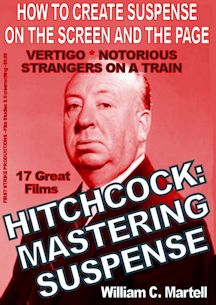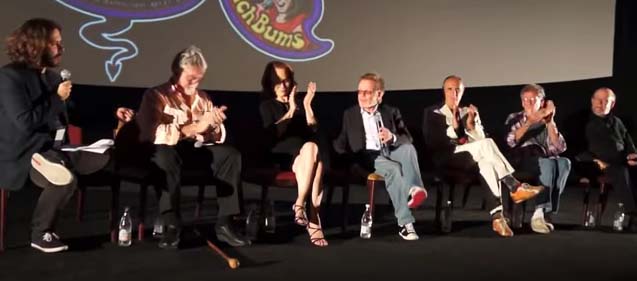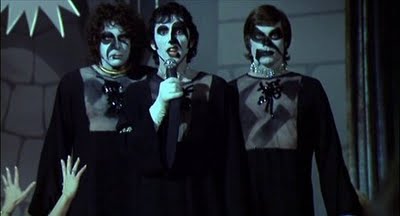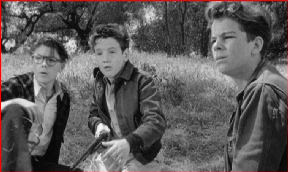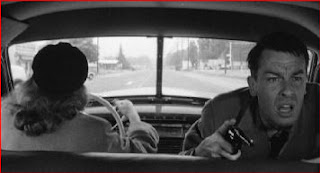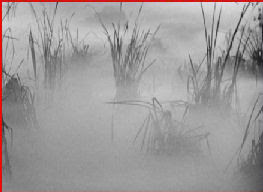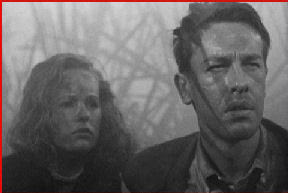The Hungry Glass
The spider web fills the screen, it's Boris Karloff's THRILLER!
Season: 1,
Episode: 16.
Airdate: January 3, 1961
Director: Douglas Heyes
Writer: Douglas Heyes based on the story by Robert Bloch.
Cast: William Shatner, Russell Johnson, Donna Dixon, Joanna Heyes, Elizabeth Allen.
Music: Jerry Goldsmith.
Cinematography: Lionel Linden.
Producer: William Frye.
Boris Karloff’s Introduction: “A beautiful young face in the mirror, a pitiful old face at the door. Could they have been one and the same? Some people say that mirrors never lie. Others say that they do: they lie, they cheat, they kill. Some say that every time you look in one you see death at work. But most of us see only what we want to see. And perhaps it’s better not to see too deeply into the darkness behind our mirrors? For there live things beyond our imagination, as sure as my name is Boris Karloff. But if you’re skeptical, stay with me and watch “The Hungry Glass” with those others who doubted. William Shatner, Joanna Heyes, Russell Johnson, and Elizabeth Allen. Oh, you’ll be perfectly safe, that is, if you turn your own mirrors to the wall... and make sure that your television screen casts no reflection.”
Synopsis: Have you ever looked into a mirror and thought you saw someone or something behind you, but when you turned there was nothing there?
This is one of those episodes from THRILLER that people often remember, and I like it better than Stephen King’s favorite PIGEONS FROM HELL. Oh, but the story...
It opens a hundred years ago with a beautiful young woman, Laura Bellman (Donna Dixon from BEVERLY HILLBILLIES), looking at herself in one ornate wall mirror after another... dozens of them! Every inch of the wall is covered with a mirror! There is an insistent knock at the door, and she goes to answer it; but the person who opens the door is a shriveled up old woman dressed exactly as that beautiful young woman. On the other side of the threshold are Laura’s sailor nephew who has a hook for a hand and a doctor... Laura hasn’t left the house and her mirrors in months. She says: “Go away! Leave me alone, can’t you? Leave me alone, with my mirrors.”
Present day: Gil Thraser (Shatner!) is a photographer who has finally gotten his Korean War post traumatic stress disorder under control, married a model who is probably close to her pull date Marcia (Joanna Heyes) and bought the Bellman House in Maine. A rambling old fixer upper on the edge of a rocky cliff overlooking the Atlantic about 2 miles from town. They are escaping the city, and hope to turn this place into their dream house. Their belongings have been sent ahead to the house by a moving company and they are waiting in the town’s little general store for the real estate agent to arrive with the keys. A storm is raging outside... and a group of old farts are sitting by the store’s old wood burning stove, staying warm and playing checkers. When Gil tells the Store Owner that they just bought the Bellman House, the old farts joke about how the house comes with unwanted guests, and lots of people who lived there died there as well, and there isn’t a single mirror in the whole place because of, you know...

That’s when real estate agent Adam Talmadge (Russell Johnson, The Professor!) arrives and tells them his wife Liz (Elizabeth Allen) is waiting in the station wagon and he’ll drive them out to the house. But first they need to buy some light bulbs... none in the house. The Store Owner says bulbs won’t matter, there’s no power. Adam says he had the power company turn it on... the Store Owner says the storm turned it back off again. They buy bulbs anyway, and make sure they have candles and batteries for the flash lights as well.
In the car, Gil asks Adam if there are vampires in the house or something? Because of the lack of mirrors? Adam explains that you take an old house where there have been a couple of accidental deaths and the locals come up with all kinds of spooky legends. Ghosts and such. None of it is real, it just gives the people in the small town something to talk about.
When they get to the house, all of there stuff is packing crates in the entry area... to be unpacked later. Adam and Liz come in with them, because they have a little house warming gift... a chilled bottle of champagne and 4 glasses. Adam has got a fire going in the fireplace, too. The living room has an *amazing* view of the ocean. Adam pours the champagne while Marcia looks out the window, and when she turns her back to the window to say something... Liz SCREAMS! Adam drops the champagne bottle, breaking it and slicing open his palm. Liz says there was a man standing outside the window, reaching for Marcia! A man with a hook for a hand! Gil runs to the window and looks out: sheer cliff all the way down to the ocean, no place for a man to stand. Must have just been some freak reflection from the fireplace, right? Adam picks the glass out of his hand... a freak accident... like the glass shards were trying to attack him. As Adam and Liz leave, Gil closes the door and sees the reflection of an old woman in the stairway window... beckoning him.
The next morning, Marcia is putting on make up using her travel mirror when she sees a man’s reflection! It’s Gil, who cut himself shaving when she snuck up on him and he saw her reflection in *his* travel mirror. So they’re even, right? Except Marcia says she hasn’t left this room. They have a great discussion/argument about whether the old house was a good investment or a bad one. They decide either way, they’re kind of stuck with it so might as well make the best of it. That’s when the power comes back on, and all of the new light bulbs turn the spooky old house into... well, less spooky. Gil says he’s going to take a bunch of pictures of the house as it is now to give them something to compare with after they fix it up.

When Gil is developing those photos, he sees a strange image reflected in one of the windows: a little girl. Is it a double exposure? Meanwhile, Marcia pokes around the attic and finds that it’s full of old furniture and things... a gold mine in antiques! She spots a door hidden behind some things with a huge padlock on it. What could be inside? Using a rusty knife from the attic junk she unscrews the hasp and has to put some muscle into getting the door open. On the other side, a storage room filled with dozens of antique mirrors! For a moment she’s blinded by her flashlight reflection... Meanwhile, Gil decides *not* to show the photo of the little girl’s reflection to Marcia (in a great piece of visual storytelling). Then goes looking for her, finds her in the attic. Marcia shows him a couple of antiques that might pay for the whole danged house... it was a great decision the buy this place. Gil asks if she might have used his camera to take a picture of a little girl, she says no. Then she shows him to weird room full of locked away mirrors and asks him to bring one down so that she can get ready for the dinner they’re going to host for the Adam & Liz. When Marcia leaves, Gil looks into one of mirrors and sees an old woman beckoning him... screams and faints!
Gil is afraid that his post traumatic stress has returned, and next he’ll be seeing all of dead people from Korea again. Marcia tells him to just calm down, it was just his imagination playing tricks on him. They have company coming for dinner and they both need to get ready. But Gil worries that he’s losing his mind. Again.
After they have finished dinner with Liz and Adam, Marcia offers to give Liz a house tour and Gil and Adam stay behind... so that Gil can ask about the reason the townspeople might think this place is haunted. Adam doesn’t want to spread silly rumors, but Gil pushes it... and Adam relates the Legend Of Bellman House.
And what a legend! Basically, everyone who has ever lived in the house has been killed by accidents involving mirrors or windows. As Adam explains death by death, including a sailor with a hook for a hand that was Mrs. Bellman’s nephew, we realize that no one has ever gotten out of this place alive. That’s when Gil tells him about the strange double exposure, and they go down to his basement darkroom. Gil shows Adam the photo... and Adam identifies the little girl as a kid who fell off the cliff to her death when the sun’s reflection in the house’s window blinded her. So, not a double exposure... a ghost reflected in the window. Now *Adam* believes the house may actually be haunted, and Gil knows he’s not crazy.
That’s when Liz interrupts them (lots of good jumps in this episode in addition to all of the creepy suspense), to bum some cigarettes. When Gil asks where Marcia is, she says Marcia was showing her the odd storeroom full of mirrors. Then they hear Marcia SCREAMING! Both men bolt up the stairs, Adam stopping to tell Liz *not* to follow them up to the attic. When Gil gets to the mirror room, he sees all of the dead people from the legend PULLING Marcia into a mirror. She screams for Gil to help her. Gil grabs an old fire poker from the attic and hits the mirror again and again until it shatters. When Adam comes in, Gil says they have taken Marcia into the mirror... but Adam points to the floor, where Marcia lies dead... beaten to death by the fire poker!

Adam and Liz try to calm and console Gil... who keeps trying to convince both of them that he saw dead people in the mirror grabbing Marcia and pulling her inside the glass. That he’s not losing his mind, it’s the mirrors! The windows! Any glass that reflects! The police will never believe him, even though it’s true!
Then Gil sees Marcia reflected in the huge living room window, and runs to embrace her... crashing through the window and falling all the way down that rocky cliff to splat on the rocks below, as the waves crash over him. Liz faints, and Adam carries her out of the house, seeing the reflection of Marcia and Gil beckoning to him from the staircase window!
Review: Wow! This episode really delivers. It’s spooky, has some great scares, is wall to wall dread (a great job of building with small spooky stuff), and is *witty* and filled with great dialogue. In fact, if you took away everything else but the dialogue, this would still be a great episode. People don’t just say things, they say it in the most amusing way possible. After Adam drops the champagne bottle and slices open his palm, he says “At least I christened the carpet”. This crackling dialogue makes the episode fun, and adds to the dread... we’re having such a great time when something scary happens it ends up twice as scary! I haven’t read the short story in a couple of decades, but Bloch is an incredibly witty writer who loves to make you smile just before he makes you scream. All of this great dialogue may have been his, or maybe the writer/director used Bloch’s tone as a guide and went with it. I don’t think there’s a bad line in the entire episode.
Director Heyes was responsible for the previous best episode, THE PURPLE ROOM, and here he makes sure every inch of that attic makes you want to get the hell out of there. When Marcia is poking around the antiques, you are waiting for something to jump out and grab her! The basement dark room is also spooky. This is a *great* haunted house story. It’s also *packed* with story... there isn’t a dull *second* in this episode, when they aren’t being scared by the windows and mirrors they are having relationship issues caused by the house or Gil is having a breakdown caused by the house. It’s almost like a feature film squeezed into an hour of TV. Never a dull moment, and the great thing about mirrors and windows and reflections is that they’re *everywhere*! When they walk past a window, you worry!

The cast is *great*, with Shatner gearing up for his TWILIGHT ZONE episode 2 years after this. He does a great job in the quiet moments, as well as going full Shatner in some of the more dramatic scenes. Russell Johnson is a charming real estate guy, completely making you forget that he was the Professor on GILLIGAN’S ISLAND. He not only gets laughs delivering the quips, he give you chills telling the legend. Joanna Heyes is the director’s hottie wife, and does a great job holding her own opposite scene stealer Shatner. Elizabeth Allen probably has the least interesting role in the episode, but screams like a pro and does a great job playing “the wife”. Donna Dixon who was Ellie May on BEVERLY HILLBILLIES is eye candy in her brief role as the reflection of Mrs. Bellman in the mirror.
Aside from the witty dialogue and great pacing, this script has some great visual storytelling (like when Gil wordlessly decides not to show the picture to Marcia) and some awesome exposition hiding... we know the house is 2 miles from the nearest neighbor because of a line about having to walk down to warn them if Liz plans on screaming again. The big chunk of exposition that comes with the Legend Of Bellman House, is a great little ghost story with twists and thrills... so you don’t notice it’s exposition... it’s a campfire story. Great writing, acting, direction...
The creepy thing about this episode is that after watching it, you start seeing things in *your* mirrors... or maybe it’s just my imagination?
Bill


